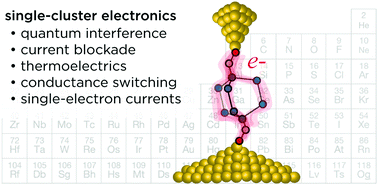Single-cluster electronics
Abstract
This article reviews the scope of inorganic cluster compounds interrogated in single-molecule break-junction measurements. This body of work lies at the intersection between the fields of inorganic cluster chemistry and single-molecule electronics, where discrete inorganic cluster molecules are used as the active components in molecular electronic circuitry. We explore the breadth of transition metal and main group cluster compounds that have been studied in single-cluster junctions, largely within the context of scanning tunnelling microscopy break-junction (STM-BJ) measurements. Our discussion centers on how the structure and bonding of inorganic cluster compounds give rise to desirable quantum transport effects such as room-temperature current blockade, sequential tunneling, voltage-gated conductance switching, destructive quantum interference, and high thermoelectric currents.

- This article is part of the themed collection: PCCP Perspectives


 Please wait while we load your content...
Please wait while we load your content...